Dynamic Mechanical Properties of Several High-Performance Single Fibers
Abstract
:1. Introduction
2. Methods and Materials
2.1. Test Method and Principle
2.2. Experimental Samples
3. Results and Discussion
3.1. Experimental Results
3.2. Weibull Strength Distribution
4. Conclusions
- (1)
- The strengths of the single PBO and aramid III fibers are more sensitive to strain rate compared to single PI fibers. In addition, the PBO fiber is superior to the other two fibers in terms of strength and elongation. However, the vulnerability when subjected to ultraviolet light needs to be improved for practical application.
- (2)
- The strength dispersion of single fibers was observed in experiments, and it enlarges with increasing strain rate, which can be ascribed to the effects of the internal defects.
- (3)
- Only the PBO fiber conforms to the Weibull strength distribution with a strain rate term, suggesting that the hypothesis of Weibull distribution for single fibers needs to be revisited.
- (4)
- The single PBO and aramid III fibers exhibit ductile-brittle transition with increasing strain rate, while the PI fiber shows plasticity for all the tested strain rates.
Author Contributions
Funding
Institutional Review Board Statement
Informed Consent Statement
Data Availability Statement
Conflicts of Interest
Nomenclature
| Strain rate | Wave speed | ||
| Strain | Reflected wave | ||
| Tensile strength | Transmitted wave | ||
| Sample length | Incident wave | ||
| Cross-sectional area of bar | Force | ||
| Cross-sectional area of sample | Cumulative failure probability | ||
| Elastic modulus | m | Shape parameter of Weibull distribution | |
| Average tensile strength at respective strain rates | N | Number of test specimens | |
| A parameter related to strain rate |
References
- Soutis, C. Fibre reinforced composites in aircraft construction. Prog. Aerosp. Sci. 2005, 41, 143–151. [Google Scholar] [CrossRef]
- Liao, K.; Schultesiz, C.R.; Hunston, D.L.; Brinson, L.C. Long-Term Durability of Fiber-Reinforced Polymer-Matrix Composite Materials for Infrastructure Applications: A Review. J. Adv. Mater. 1998, 30, 3–40. [Google Scholar]
- Rubino, F.; Nisticò, A.; Tucci, F.; Carlone, P. Marine Application of Fiber Reinforced Composites: A Review. J. Mar. Sci. Eng. 2020, 8, 26. [Google Scholar] [CrossRef] [Green Version]
- Wang, L.; Fu, X.; He, J.; Shi, X.; Chen, T.; Chen, P.; Wang, B.; Peng, H. Application Challenges in Fiber and Textile Electronics. Adv. Mater. 2020, 32, 1901971. [Google Scholar] [CrossRef]
- Mahalingam, S.; Matharu, R.; Homer-Vanniasinkam, S.; Edirisinghe, M. Current methodologies and approaches for the formation of core-sheath polymer fibers for biomedical applications. Appl. Phys. Rev. 2020, 7, 041302. [Google Scholar] [CrossRef]
- Grujicic, M.; Arakere, G.; He, T.; Bell, W.C.; Cheeseman, B.A.; Yen, C.-F.; Scott, B. A ballistic material model for cross-plied unidirectional ultra-high molecular-weight polyethylene fiber-reinforced armor-grade composites. Mater. Sci. Eng. A 2008, 498, 231–241. [Google Scholar] [CrossRef]
- Da Cruz, R.B.; Lima Junior, E.P.; Monteiro, S.N.; Leme Louro, L.H. Giant Bamboo Fiber Reinforced Epoxy Composite in Multilayered Ballistic Armor. Mater. Res. 2015, 18, 70–75. [Google Scholar] [CrossRef] [Green Version]
- Jingjing, C.; Hongqing, N.; Dezhen, W. Research Progress of Polyimide Fibers. Polym. Bull. 2017, 3, 19–27. [Google Scholar]
- Zhang, M.; Niu, H.; Lin, Z.; Qi, S.; Chang, J.; Ge, Q.; Wu, D. Preparation of High Performance Copolyimide Fibers via Increasing Draw Ratios. Macromol. Mater. Eng. 2015, 300, 1096–1107. [Google Scholar] [CrossRef]
- Chang, J.; Niu, H.; He, M.; Sun, M.; Wu, D. Structure-property relationship of polyimide fibers containing ether groups. J. Appl. Polym. Sci. 2015, 132, 42474. [Google Scholar] [CrossRef]
- Xia, L.; Yudong, H.; Lingyan, J. Synthesis and Microstructure of PBO Fiber. Polym. Bull. 2004, 04, 102–107. [Google Scholar]
- Greenwood, J.; Rose, P. Compressive Behavior of Kevlar-49 Fibers and Composites. J. Mater. Sci. 1974, 9, 1809–1814. [Google Scholar] [CrossRef]
- Zhu, L.; Sun, B.; Hu, H.; Gu, B. Constitutive equations of basalt filament tows under quasi-static and high strain rate tension. Mater. Sci. Eng. A. 2010, 527, 3245–3252. [Google Scholar] [CrossRef]
- Zhi, Z.; Yulong, L.; Yazhou, G.; Xuan, C.; Lei, W. Tension Mechanical Behavior of Two Angle-Ply of Glass-Fiber Reinforced Composites. J. Aeronaut. Mater. 2013, 33, 74–80. [Google Scholar]
- Banghai, J.; Reji, Z. Experimental Study on the Interlaminar Tensile Properties for a Kind of Carbon Fiber Woven Reinforced Composite Under Impact Loading. Fuhe Cailiao Xuebao (Acta Mater. Compos. Sin.) 2005, 22, 107–112. [Google Scholar]
- Sun, B.; Liu, F.; Gu, B. Influence of the strain rate on the uniaxial tensile behavior of 4-step 3D braided composites. Compos. Part A Appl. Sci. Manuf. 2005, 36, 1477–1485. [Google Scholar] [CrossRef]
- Wang, Y.; Xia, Y.M. Experimental study of tensile mechanical properties of Kevlar 49 fiber bundles at different strain rates. Acta Mater. Compos. Sin. 1999, 16, 45–51. [Google Scholar]
- Zhu, L.T.; Sun, B.Z. Micromechanics Analysis of the Tensile Behavior of Twaron Fiber Tows at Various Strain Rates. Adv. Mater. Res. 2011, 181–182, 749–753. [Google Scholar] [CrossRef]
- Cheng, M.; Chen, W.; Weerasooriya, T. Experimental investigation of the transverse mechanical properties of a single Kevlar® KM2 fiber. Int. J. Solids Struct. 2004, 41, 6215–6232. [Google Scholar] [CrossRef]
- Lim, J.; Zheng, J.Q.; Masters, K.; Chen, W.W. Mechanical behavior of A265 single fibers. J. Mater. Sci. 2010, 45, 652–661. [Google Scholar] [CrossRef]
- Wang, P.; Zhang, X.; Hansen, R.V.; Sun, G.; Zhang, H.; Zheng, L.; Yu, T.X.; Lu, G.; Yang, J. Strengthening and failure mechanisms of individual carbon nanotube fibers under dynamic tensile loading. Carbon 2016, 102, 18–31. [Google Scholar] [CrossRef]
- Lindholm, U. Some Experiments with the Split Hopkinson Pressure Bar. J. Mech. Phys. Solids 1964, 12, 317–335. [Google Scholar] [CrossRef]
- Li, S.; Shisheng, H. Two-wave and three-wave method in SHPB data processing. Explos. Shock. Waves 2005, 25, 368–373. [Google Scholar]
- Sanborn, B.; DiLeonardi, A.M.; Weerasooriya, T. Tensile Properties of Dyneema SK76 Single Fibers at Multiple Loading Rates Using a Direct Gripping Method. J. Dyn. Behav. Mater. 2015, 1, 4–14. [Google Scholar] [CrossRef]
- Kim, J.H.; Heckert, N.A.; McDonough, W.G.; Rice, K.D.; Holmes, G.A. Single Fiber Tensile Properties Measured by the Kolsky Bar Using a Direct Fiber Clamping Method. In Dynamic Behavior of Materials; Song, B., Casem, D., Kimberley, J., Eds.; Springer International Publishing: Cham, Switzerland, 2014; Volume 1, pp. 69–71. [Google Scholar]
- Lim, J.; Chen, W.W.; Zheng, J.Q. Dynamic small strain measurements of Kevlar (R) 129 single fibers with a miniaturized tension Kolsky bar. Polym. Test. 2010, 29, 701–705. [Google Scholar] [CrossRef]
- Islam, F.; Joannès, S.; Laiarinandrasana, L. Evaluation of Critical Parameters in Tensile Strength Measurement of Single Fibres. J. Compos. Sci. 2019, 3, 69. [Google Scholar] [CrossRef] [Green Version]
- Kitagawa, T.; Yabuki, K. An investigation into the relationship between internal stress distribution and a change of poly-p-phenylenebenzobisoxazole (PBO) fiber structure. J. Polym. Sci. Part B Polym. Phys. 2000, 38, 2901–2911. [Google Scholar] [CrossRef]
- Liu, X.Y.; Yu, W.D. The degradation of PBO fiber by heat and light. Res. J. Text. Appar. 2006, 10, 26–32. [Google Scholar] [CrossRef]
- Song, B.; Fu, Q.; Liu, X.Y.; Zhuang, Q.X.; Han, Z.W. Study on the photolysis and stabilization of PBO fiber. J. Solid Rocket. Technol. 2011, 34, 378. [Google Scholar]
- Xiong, J.; Shi, M.; Zhou, G.; Gu, B.; Wang, S. An Investigation on High Strain Rate Properties of Fiber Bundles. J. Text. Res. 2000, 21, 7–12. [Google Scholar]
- Kitagawa, T.; Murase, H.; Yabuki, K. Morphological study on poly-p-phenylenebenzobisoxazole (PBO) fiber. J. Polym. Sci. Part B Polym. Phys. 1998, 36, 39–48. [Google Scholar] [CrossRef]
- Sun, G.; Pang, J.H.L.; Zhou, J.; Zhang, Y.; Zhan, Z.; Zheng, L. A modified Weibull model for tensile strength distribution of carbon nanotube fibers with strain rate and size effects. Appl. Phys. Lett. 2012, 101, 131905. [Google Scholar] [CrossRef]
- Bohong, G.; Baozhong, S. Impact Dynamics of Textile Structural Composites; Science Press: Beijing, China, 2012. (In Chinese) [Google Scholar]
- Wang, Y.; Xia, Y. The effects of strain rate on the mechanical behaviour of kevlar fibre bundles: An experimental and theoretical study. Compos. Part A Appl. Sci. Manuf. 1998, 29, 1411–1415. [Google Scholar] [CrossRef]
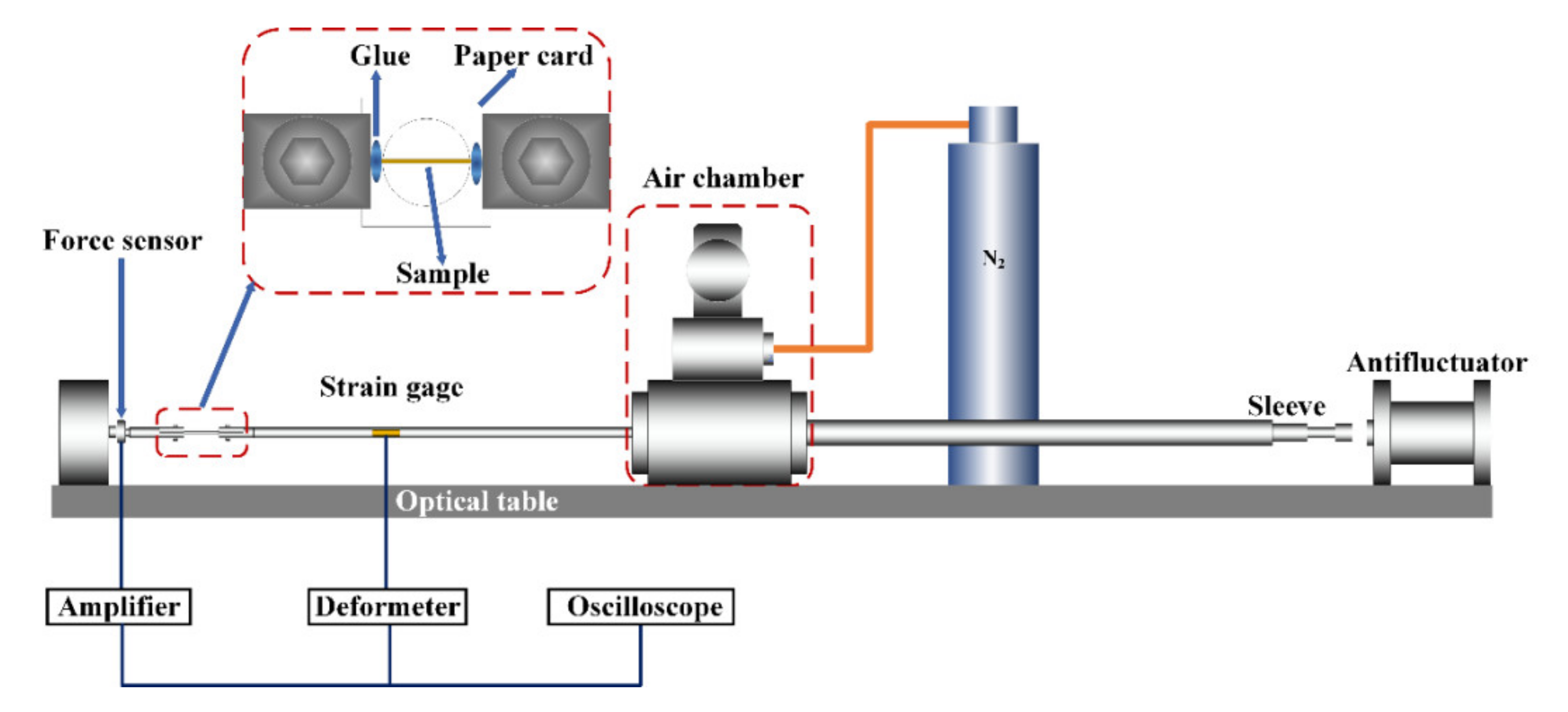

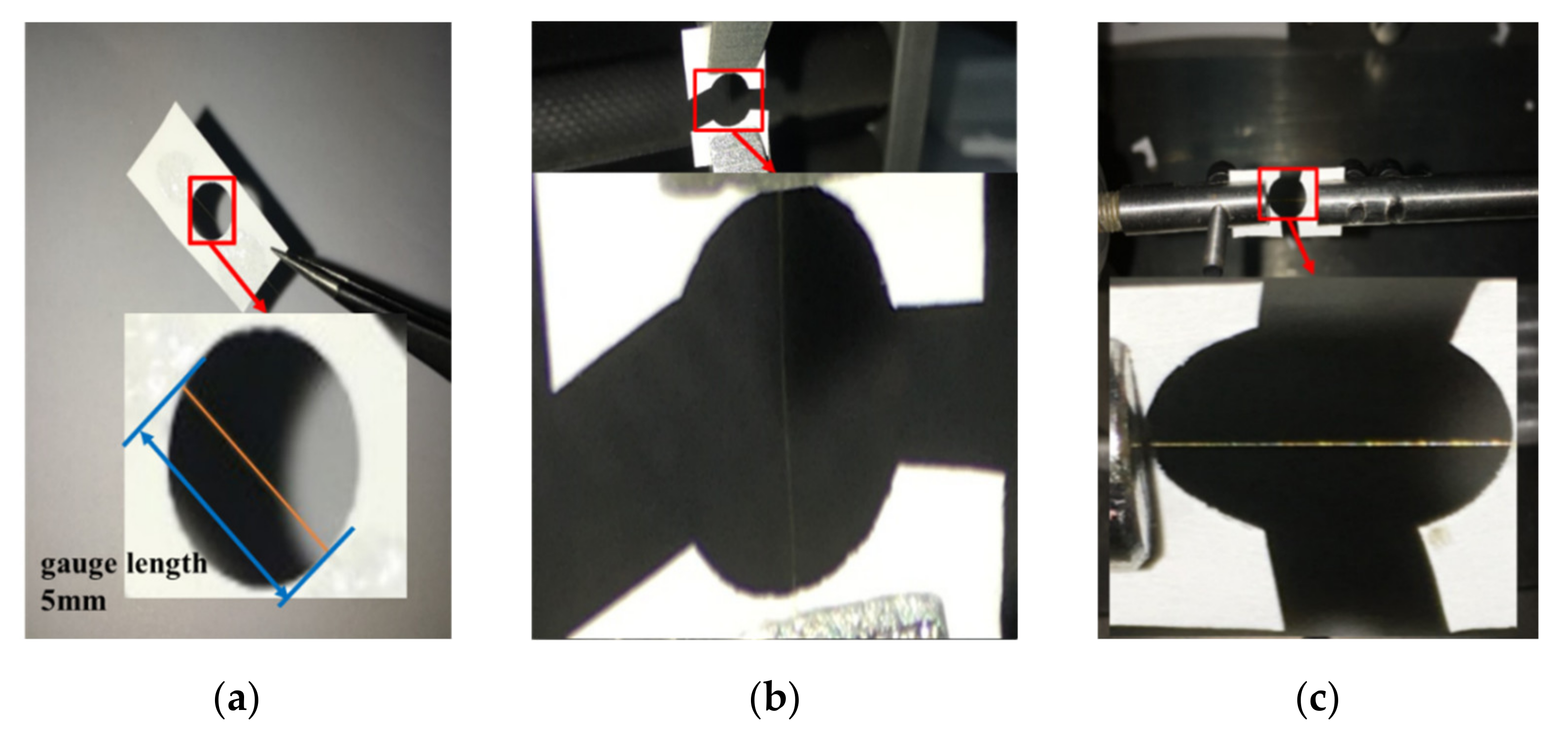

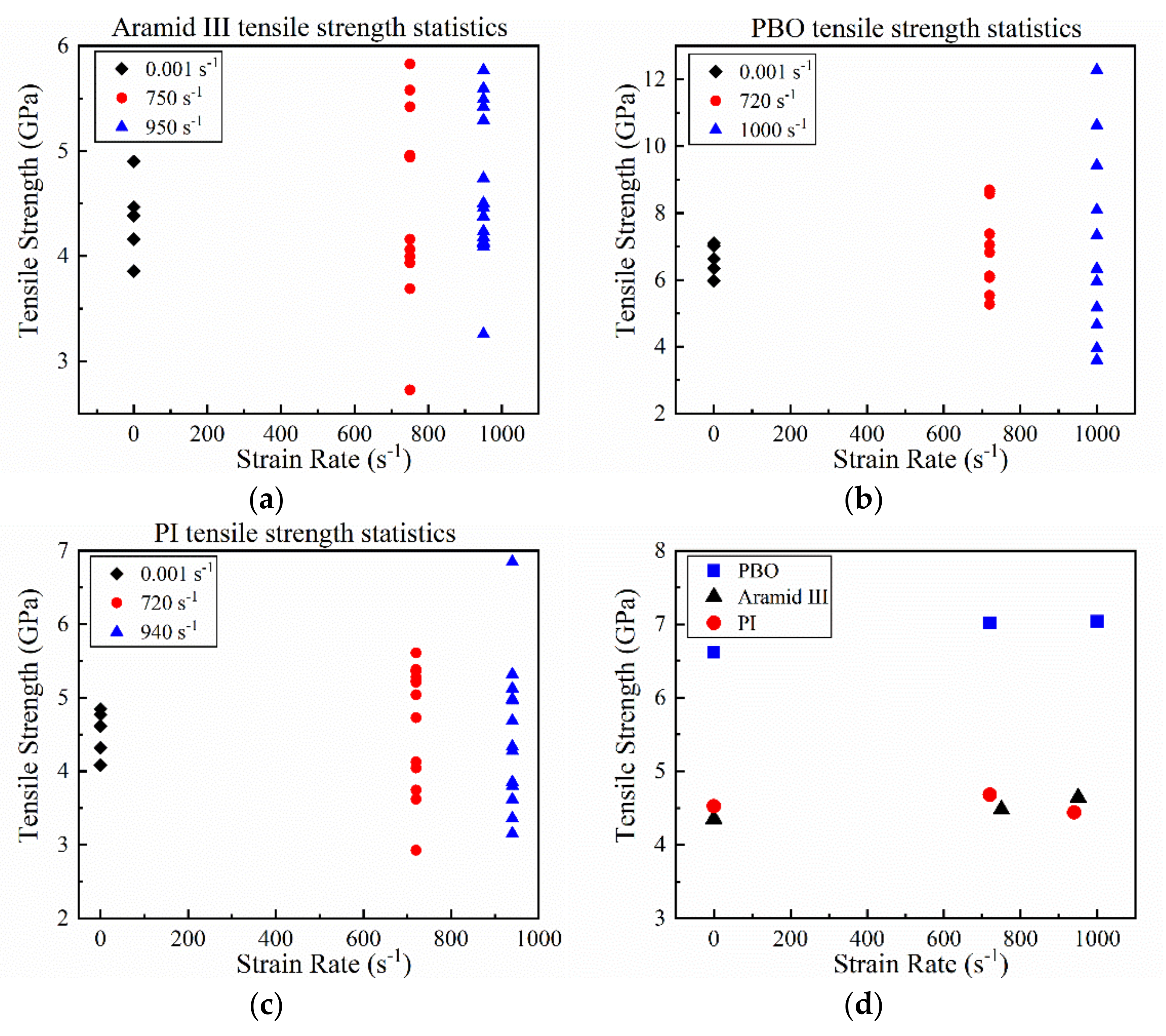
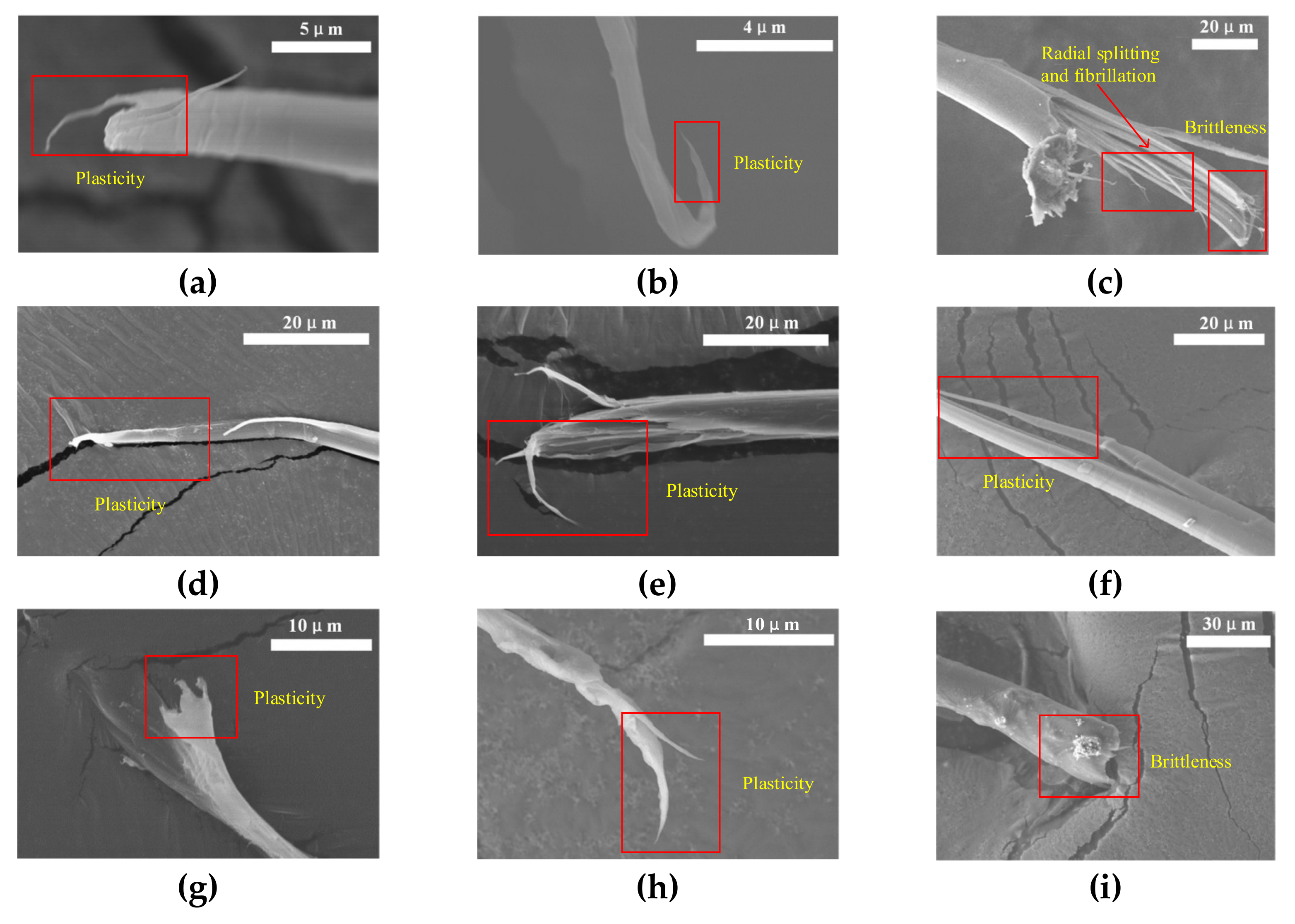

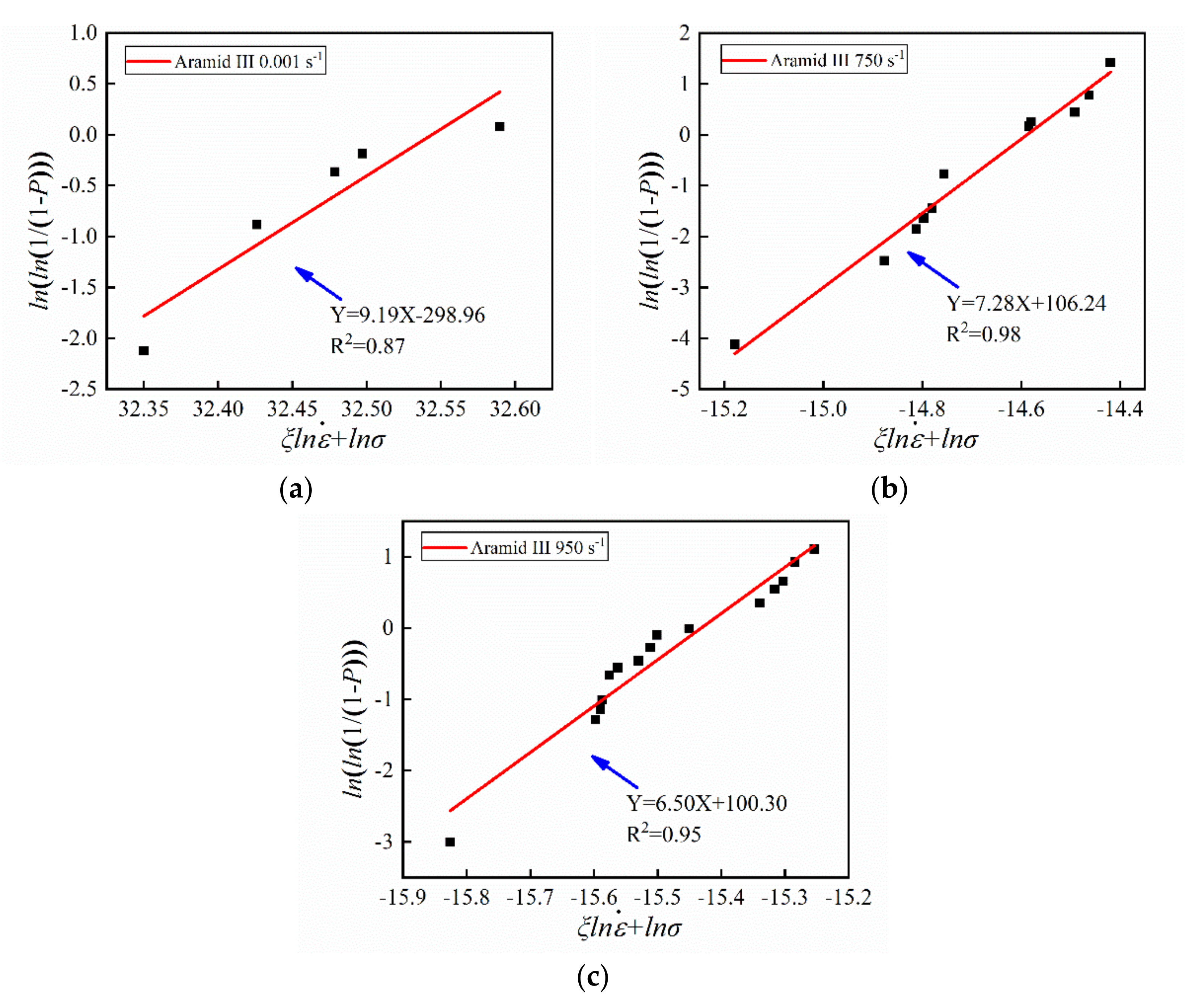
| Fiber | Diameter (μm) | Gauge Length (mm) | Number of Samples (Quasi-Static/Dynamic) | Strain Rate (s−1) |
|---|---|---|---|---|
| PBO | 14.57 | 5 | 5/15 | 0.001/720/1000 |
| Aramid III | 17.55 | 5 | 5/15 | 0.001/750/950 |
| PI | 10.08 | 5 | 5/15 | 0.001/720/940 |
| Type of Fiber | Quasi-Static (0.001 s−1) | High Strain Rate Tests | |
|---|---|---|---|
| PBO | 6.61 ± 0.47 | 7.01 ± 1.29 (720 s−1) | 7.04 ± 2.82 (1000 s−1) |
| Aramid III | 4.35 ± 0.39 | 4.48 ± 0.94 (750 s−1) | 4.64 ± 0.72 (950 s−1) |
| PI | 4.53 ± 0.32 | 4.68 ± 0.83 (720 s−1) | 4.44 ± 0.97 (940 s−1) |
| Strain Rate (s−1) | 0.001 | 720/750/720 | 1000/950/940 | Overall | |
|---|---|---|---|---|---|
| m | PBO | 5.59 | 4.47 | 4.28 | 4.36 |
| Aramid III | 9.19 | 7.28 | 6.50 | / | |
| PI | / | / | / | / |
Publisher’s Note: MDPI stays neutral with regard to jurisdictional claims in published maps and institutional affiliations. |
© 2021 by the authors. Licensee MDPI, Basel, Switzerland. This article is an open access article distributed under the terms and conditions of the Creative Commons Attribution (CC BY) license (https://creativecommons.org/licenses/by/4.0/).
Share and Cite
Lei, X.; Xiao, K.; Wu, X.; Huang, C. Dynamic Mechanical Properties of Several High-Performance Single Fibers. Materials 2021, 14, 3574. https://doi.org/10.3390/ma14133574
Lei X, Xiao K, Wu X, Huang C. Dynamic Mechanical Properties of Several High-Performance Single Fibers. Materials. 2021; 14(13):3574. https://doi.org/10.3390/ma14133574
Chicago/Turabian StyleLei, Xudong, Kailu Xiao, Xianqian Wu, and Chenguang Huang. 2021. "Dynamic Mechanical Properties of Several High-Performance Single Fibers" Materials 14, no. 13: 3574. https://doi.org/10.3390/ma14133574
APA StyleLei, X., Xiao, K., Wu, X., & Huang, C. (2021). Dynamic Mechanical Properties of Several High-Performance Single Fibers. Materials, 14(13), 3574. https://doi.org/10.3390/ma14133574






